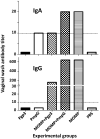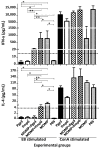The Polymorphic Membrane Protein G Has a Neutral Effect and the Plasmid Glycoprotein 3 an Antagonistic Effect on the Ability of the Major Outer Membrane Protein to Elicit Protective Immune Responses against a Chlamydia muridarum Respiratory Challenge
- PMID: 36992088
- PMCID: PMC10051784
- DOI: 10.3390/vaccines11030504
The Polymorphic Membrane Protein G Has a Neutral Effect and the Plasmid Glycoprotein 3 an Antagonistic Effect on the Ability of the Major Outer Membrane Protein to Elicit Protective Immune Responses against a Chlamydia muridarum Respiratory Challenge
Abstract
Chlamydia trachomatis is the most common bacterial sexually transmitted pathogen. The number of chlamydial infections continuous to increase and there is an urgent need for a safe and efficacious vaccine. To assess the ability of the Chlamydia muridarum polymorphic membrane protein G (PmpG) and the plasmid glycoprotein 3 (Pgp3) as single antigens, and in combination with the major outer-membrane protein (MOMP) to induce protection, BALB/c mice were immunized utilizing CpG-1826 and Montanide ISA 720 VG as adjuvants. Following vaccination with MOMP, significant humoral and cell-mediated immune responses were observed, while immunization with PmpG, or Pgp3, elicited weaker immune responses. Weaker immune responses were induced with MOMP+Pgp3 compared with MOMP alone. Following the intranasal challenge with C. muridarum, mice vaccinated with MOMP showed robust protection against body-weight loss, inflammatory responses in the lungs and number of Chlamydia recovered from the lungs. PmpG and Pgp3 elicited weaker protective responses. Mice immunized with MOMP+PmpG, were no better protected than animals vaccinated with MOMP only, while Pgp3 antagonized the protection elicited by MOMP. In conclusion, PmpG and Pgp3 elicited limited protective immune responses in mice against a respiratory challenge with C. muridarum and failed to enhance the protection induced by MOMP alone. The virulence of Pgp3 may result from its antagonistic effect on the immune protection induced by MOMP.
Keywords: Chlamydia muridarum; adjuvants; major outer membrane protein; mouse; plasmid glycoprotein 3; polymorphic membrane protein G; vaccine.
Conflict of interest statement
The authors declare no conflict of interest.
Figures









Similar articles
-
Comparison of the nine polymorphic membrane proteins of Chlamydia trachomatis for their ability to induce protective immune responses in mice against a C. muridarum challenge.Vaccine. 2017 May 2;35(19):2543-2549. doi: 10.1016/j.vaccine.2017.03.070. Epub 2017 Apr 3. Vaccine. 2017. PMID: 28385608 Free PMC article.
-
A vaccine formulated with a combination of TLR-2 and TLR-9 adjuvants and the recombinant major outer membrane protein elicits a robust immune response and significant protection against a Chlamydia muridarum challenge.Microbes Infect. 2014 Mar;16(3):244-52. doi: 10.1016/j.micinf.2013.11.009. Epub 2013 Nov 27. Microbes Infect. 2014. PMID: 24291713 Free PMC article.
-
Evaluation of Four Adjuvant Combinations, IVAX-1, IVAX-2, CpG-1826+Montanide ISA 720 VG and CpG-1018+Montanide ISA 720 VG, for Safety and for Their Ability to Elicit Protective Immune Responses in Mice against a Respiratory Challenge with Chlamydia muridarum.Pathogens. 2023 Jun 22;12(7):863. doi: 10.3390/pathogens12070863. Pathogens. 2023. PMID: 37513710 Free PMC article.
-
Vaccination against Chlamydia genital infection utilizing the murine C. muridarum model.Infect Immun. 2011 Mar;79(3):986-96. doi: 10.1128/IAI.00881-10. Epub 2010 Nov 15. Infect Immun. 2011. PMID: 21078844 Free PMC article. Review.
-
Chlamydial polymorphic membrane proteins: regulation, function and potential vaccine candidates.Virulence. 2016;7(1):11-22. doi: 10.1080/21505594.2015.1111509. Epub 2015 Nov 18. Virulence. 2016. PMID: 26580416 Free PMC article. Review.
Cited by
-
Progress towards effective vaccines for Chlamydia trachomatis.Curr Opin Infect Dis. 2025 Feb 1;38(1):54-59. doi: 10.1097/QCO.0000000000001075. Epub 2024 Nov 20. Curr Opin Infect Dis. 2025. PMID: 39745334 Review.
-
Advances in Chlamydia trachomatis Vaccination: Unveiling the Potential of Major Outer Membrane Protein Derivative Constructs.Microorganisms. 2024 Jun 13;12(6):1196. doi: 10.3390/microorganisms12061196. Microorganisms. 2024. PMID: 38930578 Free PMC article. Review.
References
-
- CDC . Prevention DoS. U.S. Department of Health and Human Services; Atlanta, GA, USA: 2021. Sexually transmitted disease surveillance 2019; pp. 1–168.
-
- Darville T. Recognition and treatment of chlamydial infections from birth to adolescence. Adv. Exp. Med. Biol. 2013;764:109–122. - PubMed
-
- Gotz H., Lindback J., Ripa T., Arneborn M., Ramsted K., Ekdahl K. Is the increase in notifications of Chlamydia trachomatis infections in Sweden the result of changes in prevalence, sampling frequency or diagnostic methods? Scand. J. Infect. Dis. 2002;34:28–34. doi: 10.1080/00365540110077001. - DOI - PubMed

